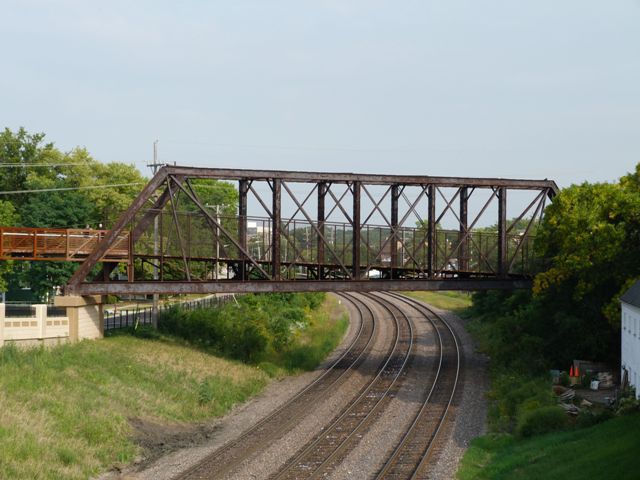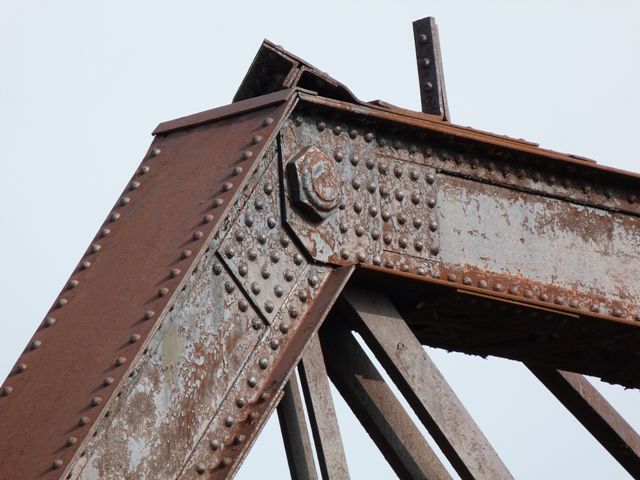We Recommend:
Bach Steel - Experts at historic truss bridge restoration.
Volunteer Bridge

Primary Photographer(s): Nathan Holth
Bridge Documented: September 10, 2011
Railroad (Rail-Trail - Illinois Prairie Path) Over Railroad (Metra Union Pacific West and Union Pacific)
Wheaton: DuPage County, Illinois: United States
1902 By Builder/Contractor: King Bridge Company of Cleveland, Ohio
Not Available or Not Applicable
159.0 Feet (48.5 Meters)
Not Available
13.9 Feet (4.24 Meters)
1 Main Span(s)
Not Applicable

View Information About HSR Ratings
Bridge Documentation
Additional Information: John Marvig appears to have finally found the builder and correct date for this bridge: 1902 by King Bridge Company.
About This Bridge
This railroad bridge is located on a former railroad line that has been converted into the Illinois Prairie Path rail-trail. The bridge is a noteworthy truss bridge with pinned connections and a heavy skew of approximately 39 degrees. The exact construction date is unknown but dates of 1909 and 1907 have been suggested. Although the deck system has been reconstructed for non-motorized use, the truss itself retains excellent historic integrity with no major alterations noted. The substructure in contrast has been significantly altered. The northern end of the truss bridge actually sits on riveted steel bents, but these have been encased in concrete.
A Critical Review of A Bridge Preservation Project
It is certainly not HistoricBridges.org's goal to condemn well-intentioned preservation projects such as this one. A lot of community support, effort, and money came together to keep this historic railroad truss bridge preserved and in service for non-motorized traffic. The beautiful historic railroad truss is a signature feature of the Illinois Prairie Path. However, this project falls so short of its potential for greatness that a highly critical review of the project is needed simply so that future preservation projects do not make the same mistakes again and so lessons can be learned from the shortcomings of the project.
First, some notes about the project. At the outset of the project, the railroad bridge included three welded steel pony truss approach spans, one 66 foot span, one 62.3 foot span and, one 76.8 span all with 7.5 foot walkway width which were erected in the early 1980s during a reconfiguration of the bridge and trail. The project as executed involved replacing and reconfiguring this approach system using similar modern prefabricated spans. The spans were of varying lengths including a 74.6 foot span, a 62.5 foot span, a 76.5 foot span and a 100 foot span.
The historic railroad truss had cyclone fencing added to the inside of the truss lines. These fences provide safety for pedestrians on the bridge and trains below. However, it would have been nicer to see some other form of protective barrier placed on the bridge. The cyclone fence has a visually unattractive appearance, and it severely blocks the view of the intricate parts of the historic truss bridge. It even covers up a plaque from when the bridge was first converted into a trail bridge. HistoricBridges.org was unable to get a clean photo of this plaque. The problem can also be seen by looking at HistoricBridges.org's photos attempting to show built-up beams and bottom chord connections. Other varieties of fences, railings, and barriers exist and it would have been nice to see something more tasteful used here. Also, one way to improve the visual appearance of the truss bridge and to enable easier viewing of the truss parts would have been to mount the fences on the outside of the truss line. This way, when crossing the bridge the visual sights on the bridge would be dominated by the historic truss rather than the cyclone fencing. This method of railing mounting was used on the Cherry Avenue Bridge in Chicago.
The greatest shortcoming of the project is in fact nothing short of a devastating and needless loss of an important historic bridge. The project to repair the historic truss and reconstruct the approach system occurred as part of the same contract which replaced the parallel Wesley Street Bridge. The Wesley Street Bridge was a historic pony truss bridge with riveted connections and the bridge had an interesting history and was historically significant. The historic Wesley Street Bridge was originally fabricated in 1887 with an approximately 64 foot span. In 1916, it was lengthened to 71.5 feet and moved to the Wesley Street location. In 1956 a new timber deck with asphalt overlay was installed. The width of the bridge was 32 feet. The bridge was an extremely early example of a truss bridge with riveted connections, particularly for the Midwest United States. Although altered in 1916, this alteration was so old that the alteration itself was historic. It demonstrated not only how versatile truss bridges were but also how engineers of the period exploited this versatility by relocating, redesigning, and reusing truss bridges when they became inadequate for their previous location. The contract for the project involved the complete demolition of this historic pony truss span. How was this a shortcoming for the railroad bridge project? Because this historic truss bridge could have and should have been relocated and reused in the reconstruction of the railroad bridge's approach system. Pony truss bridges like the Wesley Street Bridge can often be restored for non-motorized use for similar or lesser cost than constructing a new pedestrian bridge, particularly when the resources of engineers and fabricators experienced with historic bridges are utilized. The 71.5 foot length of the historic bridge was so close to the 74.6 foot span that with a few very minor adjustments the span would have been a perfect approach span for the railroad bridge. The relatively wide highway truss bridge could have been narrowed to a width appropriate for the trail system. Indeed such a project would have been a sort of echo of the reuse and changes made to the historic pony truss bridge back in 1916. As a highway bridge made narrower and only used for non-motorized traffic, the bridge would be far stronger and prepared to offer a far longer service life than the modern MOB bridges. The cost would likely have not been much if any more expensive. It would have been a unique project the city could be proud of where two historic bridges had been saved through creative project design.
Prefabricated welded truss mail-order bridges (MOBs) that so frequently end up on golf courses and non-motorized trailways are one of the biggest wastes of materials, money, and potential in the transportation industry. Essentially, every time a MOB bridge is erected an opportunity to relocate and preserve a historic metal truss bridge has been lost. There are so many historic truss bridges either slated for demolition and replacement or abandoned in place that there are always historic truss bridges available for relocation and reuse. By choosing to erect a modern MOB bridge instead of reusing a historic bridge, a group may in fact be condemning a historic bridge to demolition. HistoricBridges.org can assist interested groups in finding a historic bridge that meets their needs.
![]()
Photo Galleries and Videos: Volunteer Bridge
Structure Overview
Original / Full Size PhotosA collection of overview photos that show the bridge as a whole and general areas of the bridge. This gallery offers photos in the highest available resolution and file size in a touch-friendly popup viewer.
Alternatively, Browse Without Using Viewer
![]()
Structure Details
Original / Full Size PhotosA collection of detail photos that document the parts, construction, and condition of the bridge. This gallery offers photos in the highest available resolution and file size in a touch-friendly popup viewer.
Alternatively, Browse Without Using Viewer
![]()
Structure Overview
Mobile Optimized PhotosA collection of overview photos that show the bridge as a whole and general areas of the bridge. This gallery features data-friendly, fast-loading photos in a touch-friendly popup viewer.
Alternatively, Browse Without Using Viewer
![]()
Structure Details
Mobile Optimized PhotosA collection of detail photos that document the parts, construction, and condition of the bridge. This gallery features data-friendly, fast-loading photos in a touch-friendly popup viewer.
Alternatively, Browse Without Using Viewer
![]()
Maps and Links: Volunteer Bridge
Coordinates (Latitude, Longitude):
Search For Additional Bridge Listings:
Bridgehunter.com: View listed bridges within 0.5 miles (0.8 kilometers) of this bridge.
Bridgehunter.com: View listed bridges within 10 miles (16 kilometers) of this bridge.
Additional Maps:
Google Streetview (If Available)
GeoHack (Additional Links and Coordinates)
Apple Maps (Via DuckDuckGo Search)
Apple Maps (Apple devices only)
Android: Open Location In Your Map or GPS App
Flickr Gallery (Find Nearby Photos)
Wikimedia Commons (Find Nearby Photos)
Directions Via Sygic For Android
Directions Via Sygic For iOS and Android Dolphin Browser
USGS National Map (United States Only)
Historical USGS Topo Maps (United States Only)
Historic Aerials (United States Only)
CalTopo Maps (United States Only)







